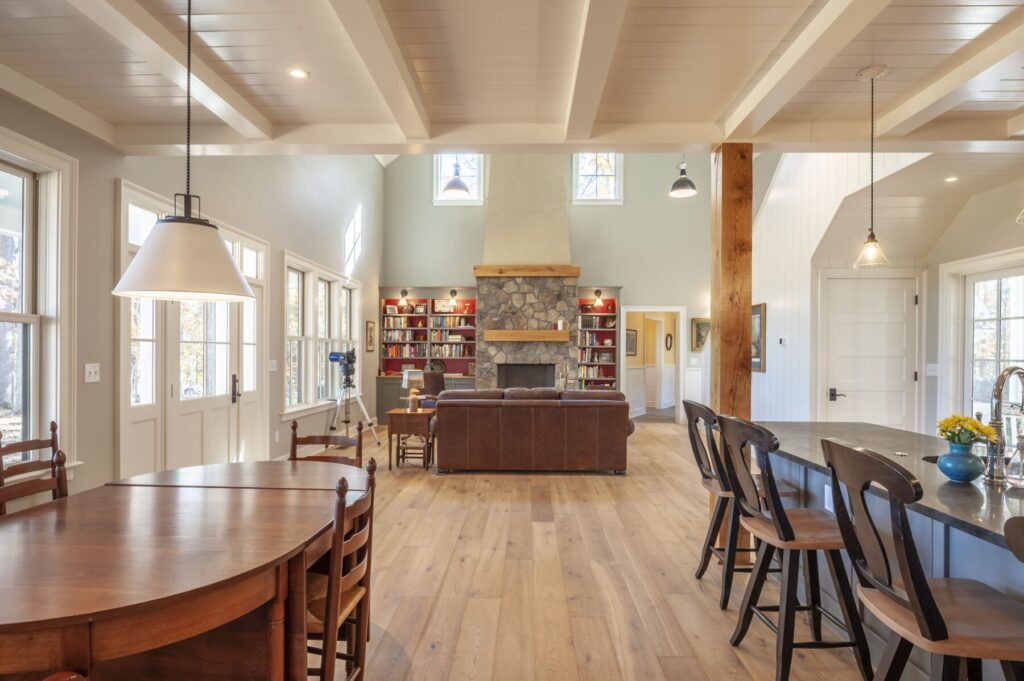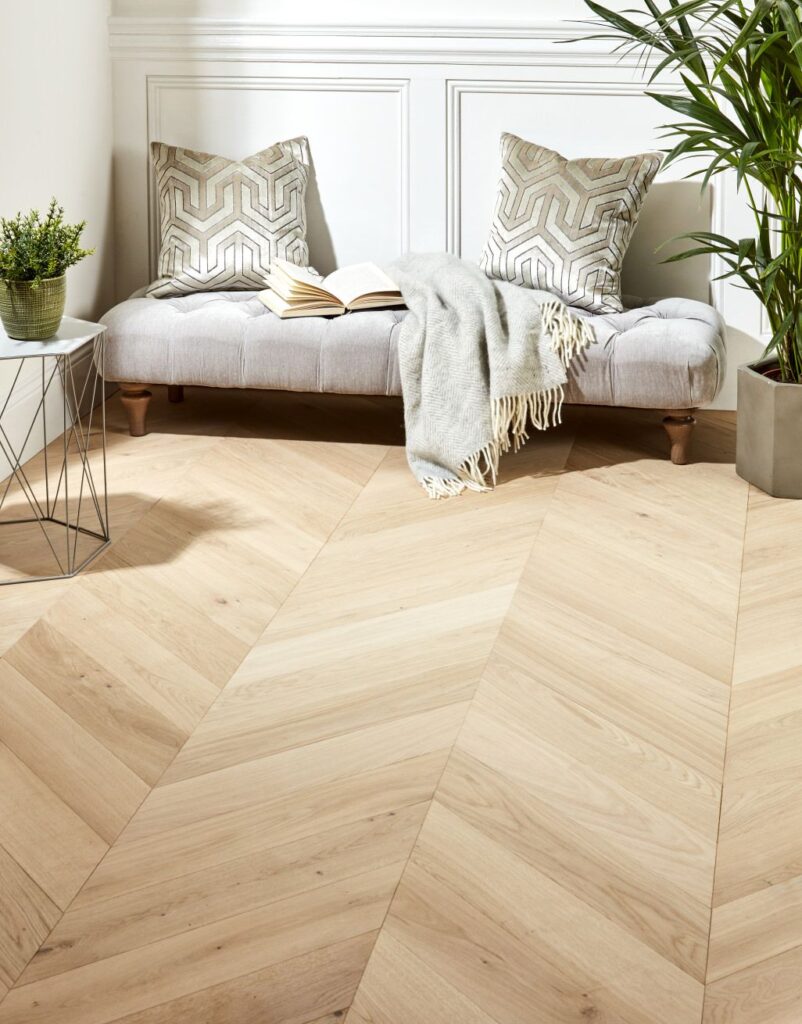Straight Pattern

The straight pattern is a widely-used, classic wood flooring layout, known for its simplicity and adaptability. In this design, wood planks are installed end-to-end in a continuous line. Installing the flooring parallel to the room’s longest wall generally makes the room look and feel larger. It creates a clean, linear appearance that contributes to a sense of order and harmony within the space.
Suitable for various plank sizes, it can be tailored to your preferences and requirements. And because of its simplicity, it blends with a wide range of interior design styles, from contemporary to traditional, without overpowering the overall aesthetic.
Advantages
- Easy installation: The straight pattern requires minimal planning and expertise, making it a more accessible option for DIY projects.
- Cost-effectiveness: With fewer cuts and less waste, the straight pattern is typically more affordable than intricate designs.
- Versatile design: It complements a wide range of interior styles, from traditional to contemporary.
Disadvantages
- Less visual impact: The simplicity of the straight pattern may not make a strong design statement compared to more elaborate patterns.
- Less hiding of flaws: In some cases, the straight pattern can accentuate flaws in the flooring or room.
Diagonal Pattern

The diagonal pattern features planks laid at a 45-degree angle to the room’s walls. This layout creates an eye-catching and dynamic effect, drawing the eye from one corner to another. This pattern alters the room’s perceived dimensions, making it appear more spacious and open, particularly in square rooms. So, if you’re looking for a subtle but unique accent, you might try the diagonal pattern.
Advantages
- Visual expansion effect: The diagonal pattern can make a room appear larger and more open by guiding the eye along the angled lines. It adds visual interest and depth to a space, particularly in smaller or narrower rooms.
- Unique design: The diagonal pattern stands out from more traditional layouts, offering a distinctive look.
Disadvantages
- More complex installation: Laying the planks at a 45-degree angle requires additional planning, cutting, and expertise.
- Increased material waste: The diagonal pattern may produce more waste during installation, as the angled cuts result in offcuts.
Herringbone Pattern

The herringbone pattern is a sophisticated wood flooring design in which the rectangular planks are zigzagged. Each one is at a 90-degree angle to its adjacent planks, forming a series of interconnected V-shapes that run the length or width of the room. This intricate arrangement results in a visually striking and elegant layout that instantly captures attention. It adds depth and texture to the room, creating a sense of movement and visual interest that sets it apart from more conventional flooring patterns.
Advantages
- Classic and elegant design: The herringbone pattern has a rich history and a timeless appeal. Use it whether you have a traditional or modern home.
- Energetic visual dynamic: The intricate layout creates a sense of movement and energy in a room.
- Wood species versatility: This pattern can be used with numerous wood types, so you can choose your preferred color and grain.
Disadvantages
- Complex installation process: The herringbone pattern requires precise planning, cutting, and installation, making it more labor-intensive and costly.
- Higher material and labor costs: The intricate design can result in increased waste and higher overall costs compared to simpler patterns.
Chevron Pattern

The chevron pattern is a cousin to the herringbone. It has wood planks cut into parallelogram shapes with mitered edges, which allows them to fit together in a continuous V-shaped pattern. Unlike the herringbone pattern, which features rectangular planks arranged in a zigzag pattern with overlapping ends, the chevron pattern’s planks have angled ends that meet at a point, creating a more streamlined and continuous flow.
Advantages
- Eye-catching design: The chevron pattern’s bold and striking layout makes a strong visual statement in any room.
- Lengthening and widening effect: The V-shaped pattern can help to create an illusion of added width or length in a room.
- Wood species versatility: Like the herringbone pattern, the chevron pattern can be used with different wood types.
Disadvantages
- Difficult installation: The chevron pattern requires planks to be cut with mitered edges and arranged in an intricate V-shaped layout. This necessitates precise measurements, cuts, and alignment. Because of its complexity, it may require a professional with specific experience in installing chevron floors.
- Increased material and labor costs: Due to the intricacy of the chevron pattern, there is a greater potential for waste when cutting the wood planks to the required dimensions. This waste, combined with the need for specialized labor and longer installation time, can lead to higher overall costs compared to more straightforward flooring patterns.
Parquet Pattern

Parquet flooring simply describes flooring that includes patterns made from small, geometrically arranged wood pieces. The designs range from relatively simple configurations, such as square or rectangle-based arrangements, to more complex and elaborate compositions. Parquet flooring has long been associated with luxury and elegance, as it was often used in grand homes and palaces to showcase the skills of master craftsmen.
Advantages
- Intricate designs: Parquet flooring offers an opportunity to create unique and ornate patterns, adding a luxurious touch to any room.
- Customizable patterns: Choose from a wide range of designs or even create your own.
- Timeless appeal: Classic and elegant, parquet flooring has enduring popularity and appeal.
Disadvantages
- Expensive installation: Parquet’s intricate geometric patterns can be more complex and time-consuming to install than simpler wood flooring options. This complexity requires skilled labor and meticulous attention to detail, making the installation process more costly than other wood flooring alternatives.
- Maintenance considerations: Due to the elaborate designs and the way the small wood pieces are fitted together in parquet flooring, it may require more specialized care and maintenance to preserve its appearance and longevity. It may also be more susceptible to moisture-related issues, so extra care must be taken to prevent water damage or warping—consider investing in a floor data logger to monitor its moisture.